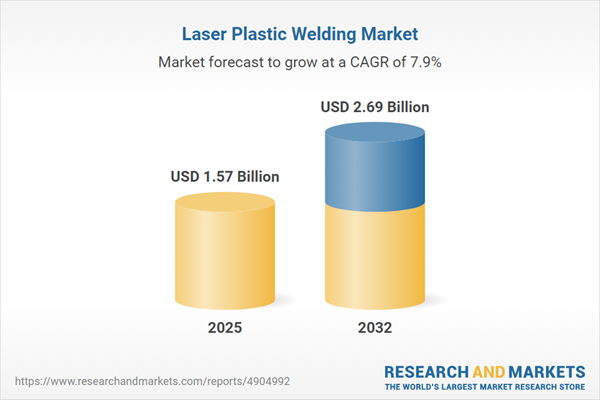Speak directly to the analyst to clarify any post sales queries you may have.
Laser plastic welding is redefining precision manufacturing by providing a highly efficient, contactless joining technique for thermoplastic components across multiple industries. Senior business leaders evaluating modern assembly solutions will find laser-based welding crucial for product integrity, throughput, and adaptability in advanced production environments.
Market Snapshot: Laser Plastic Welding Market Overview
The global Laser Plastic Welding Market grew from USD 1.46 billion in 2024 to USD 1.57 billion in 2025. The market is set to grow at a CAGR of 7.91%, reaching USD 2.69 billion by 2032. Growth is driven by rising demand for precise, high-strength, and efficient joining methods in key sectors such as automotive, medical, electronics, and packaging. These technologies enable manufacturers to meet demands for smaller, more complex components while maintaining optimized cost structures and rigorous quality standards.
Scope & Segmentation
This report covers the breadth of the laser plastic welding landscape, analyzing competitive, technological, and regulatory drivers that shape its evolution. It provides an extensive market segmentation, ensuring actionable guidance for leaders aiming to align production, procurement, and innovation strategies.
- End Use Industries: Automotive (including exterior, interior, lighting, powertrain), Consumer Goods (household appliances, power tools, toys, sporting goods, wearables), Electronics and Electrical (battery assemblies, connectors, PCBs, sensors), Medical Devices (diagnostic systems, delivery mechanisms, implantables, surgical instruments), Packaging (blister, caps, containers, tubes).
- Material Types: ABS (flame retardant, general purpose), PC/ABS (standard, variable), Polycarbonate (recycled, virgin), Polypropylene (copolymer, homopolymer).
- Applications: Automotive, Consumer Goods, Electronics & Electrical, Medical, Packaging.
- Laser Source Technologies: CO2 (AC discharge, DC discharge), Diode Laser (bar, stack), Fiber Laser (multi mode, single mode).
- Equipment Types: Integrated modules (inline, robot-mounted), Portable welding (handheld, robotic effector), Standard systems (bench top, floor standing).
- Power Outputs: Less than 100 watt, 100–500 watt, above 500 watt.
- Wavelength Categories: Mid infrared, Near infrared.
- Join Configurations: Butt joint, hem joint, lap joint, T joint.
- Geographical Regions: Americas (e.g., U.S., Canada, Mexico, Brazil, Argentina), Europe, Middle East & Africa (UK, Germany, France, Russia, South Africa, UAE, Turkey), Asia-Pacific (China, India, Japan, Australia, South Korea, Indonesia).
- Key Players: TRUMPF GmbH + Co. KG, Coherent Inc., IPG Photonics Corporation, Han's Laser, Amada Miyachi America, LPKF Laser & Electronics AG, Panasonic Corporation, Synrad Inc., Leister Technologies AG, Laserline GmbH.
Key Takeaways for Decision-Makers
- Laser plastic welding supports precision joining for miniaturized, complex products—vital in automotive electronics, medical devices, and consumer wearables.
- Its non-contact, focused process increases production line throughput, enables cleanroom operation, and minimizes heat-induced distortion or residual stress.
- Upgrades in laser source power, beam manipulation, and modular attachments facilitate easy integration into robotic and automated assembly lines.
- Developments in process monitoring and digital traceability address stringent quality and regulatory commitments across highly regulated sectors.
- Use of recycled thermoplastics and selective energy input aligns with circular economy initiatives, supporting resource efficiency and environmental compliance.
- As global supply chains evolve, agility in technology adoption and supplier diversification becomes key to maintaining competitiveness.
Tariff Impact: Navigating Supply Chain Disruptions and Cost Structures
Announced U.S. tariff changes for 2025 affect imported laser welding machinery, optical parts, and thermoplastic materials. These revisions prompt manufacturers to reassess supply chain resilience, exploring alternate sourcing and localized production. Nearshoring strategies, dual-sourcing critical subassemblies, and renegotiating supplier agreements are emerging as techniques to mitigate tariff-driven cost increases, while some OEMs consider investing in domestic manufacturing capabilities to sustain project timelines and cost competitiveness.
Methodology & Data Sources
This analysis relies on comprehensive primary interviews with OEMs, material suppliers, and end users, supplemented by secondary research from industry publications and patent data. Triangulation of insights and rigorous expert review ensure robust, credible, and transparent findings to guide strategic decisions.
Why This Report Matters
- Delivers actionable strategies tailored for leaders optimizing manufacturing, sourcing, and investment in laser plastic welding technologies.
- Clarifies the competitive and regulatory landscape, supporting informed capital allocation and risk management.
- Enables effective benchmarking for technology deployment, cost reduction, and sustainability initiatives within high-value industrial segments.
Conclusion
Laser plastic welding continues to advance as an essential technology for precision assembly across diverse industries. This report empowers senior leaders to shape resilient operations and capitalize on emerging opportunities in dynamic, high-growth markets.
Additional Product Information:
- Purchase of this report includes 1 year online access with quarterly updates.
- This report can be updated on request. Please contact our Customer Experience team using the Ask a Question widget on our website.
Table of Contents
3. Executive Summary
4. Market Overview
7. Cumulative Impact of Artificial Intelligence 2025
Companies Mentioned
The companies profiled in this Laser Plastic Welding market report include:- TRUMPF GmbH + Co. KG
- Coherent, Inc.
- IPG Photonics Corporation
- Han's Laser Technology Industry Group Co., Ltd.
- Amada Miyachi America, Inc.
- LPKF Laser & Electronics AG
- Panasonic Corporation
- Synrad, Inc.
- Leister Technologies AG
- Laserline GmbH
Table Information
| Report Attribute | Details |
|---|---|
| No. of Pages | 190 |
| Published | October 2025 |
| Forecast Period | 2025 - 2032 |
| Estimated Market Value ( USD | $ 1.57 Billion |
| Forecasted Market Value ( USD | $ 2.69 Billion |
| Compound Annual Growth Rate | 7.9% |
| Regions Covered | Global |
| No. of Companies Mentioned | 11 |









